
Obtaining Food at Sea Menu: 1 2 3 4 5 6 7 8 9 10 11 Next>>
Obtaining Food at Sea During the Golden Age of Piracy, Page 8
Obtaining Food at Sea in the Late 17th and Early 18th Centuries - Taking
Pirates Taking Food
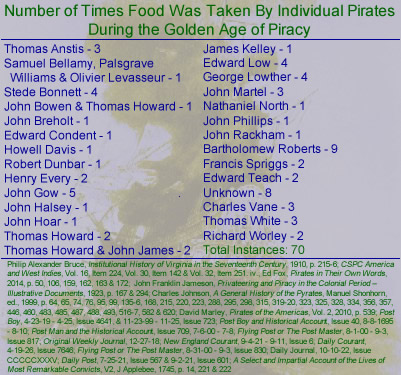
Number of Times Food was Taken by Individual Pirates During the GAoP
Image Artist: Howard Pyle - Burning Ship in a Pirate Raid (1898)
The largest number of recorded captures of food in the accounts under study were attributed to pirates. The material under study contains 30 different pirate captains' crews taking food in 70 different instances. The names of the pirate captains who took food and the number of times they were noted as doing so appear in the chart at right. Where more than one pirate captain is mentioned in an account that is indicated as a separate entry in the chart.
The pirates during sailing from 1690 - 1725 can be broadly divided into three categories based on where they were most active - those in (primarily active from 1714-1725), those in the East Indies (primarily active from 1690 - 1704) and European pirates. Note that these categories are quite broad and there are some outlying examples in the pirate history from this time which don't fit neatly into them. However, their used here helps to better organize the large number of examples for easier comprehension. The majority of the these accounts (55) are from the Atlantic-based pirates who marauded on the coast of America, the West Indies, Brazil and the west African Coast. The minority (15) are pirates operating in the East Indies who were largely based on Madagascar. Some of these ships also took vessels in the Atlantic, although that was not their primary area of operation.
Pirates Operating in the East Indies Taking Food
Edward Condent (which may have been a pseudonym because he has been identified by a variety of other names in the period documents including William, Christopher, Edmond and John /
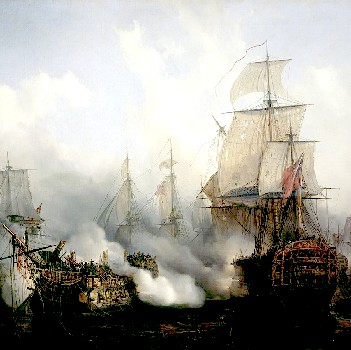
Artist: Auguste Étienne François Mayer - Sea Battle (1838)
Congdon, Coudon, Connor and Condell... as well as Billy One Hand) started in the West Indies and eventually moved to the East Indies. The account of him taking food comes from his crew taking a salt fleet of twenty ships at Maio, one of the Cape Verde Islands, probably in late 1718. "He took what Provisions and other Necessaries he wanted, and having augmented his Company, by Voluntiers and forced Men, he left the Ships and sailed to St. Jago [Santiago, Cape Verde Islands]"1.
This account is illustrative of several of the other pirate accounts in this section in that it simply says that pirates took 'provisions' without providing any further details of the things taken. This term is frequently used in sailors accounts to refer to food, water, alcohol or any combination of three. Similarly, the term 'necessaries' often refers to items needed to operate the ship such as lines, anchors, sails, navigation equipment and possibly even medical equipment. Since many of the accounts which mention taking 'provisions' fail to provide much detail beyond that, there is little reason to quote them in full here unless there is some other point of interest in the narrative.
In fact, the majority of the pirates operating in the East Indies are merely said to have taken 'provisions'. These include Henry Every taking three English vessels at Maio in early 16952,
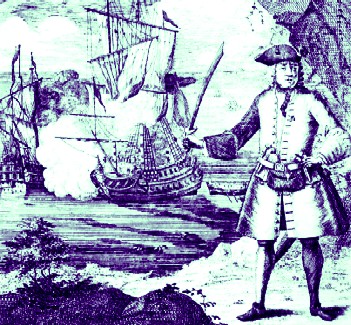
Pirate Henry Every With His Ship Fancy Taking the Ganj-i-Sawai (1702)
James Kelly capturing three Spanish ships around 16843, John Bowen and Thomas Howard sailing in consortship in March, 1703 taking the East Indiaman Pembroke4, Howard sailing with pirate John James near the Cayman Islands in 1698 where they captured an Irish Brigantine5 and a New England Brigantine6, Howard sailing alone off the coast of Virginia in 1699 where he took several English ships7 and finally Thomas White who took provisions in three different captures including two grabs taken near the islands at Bab-el-Mandeb Straight in 1704 or 17058, a ketch in the Persian Gulf 9 and another ketch in the bay off of Dafar (in what is today Iran) in the Gulf10, each of which were captured in 1706.
One East Indies pirate account does give some details of some interest regarding the capture of food, although it still only lists what was taken as 'provisions'. This concerns pirate Nathaniel North who was sailing with a group of 'privateers' in 1701. Upon reaching Anjouan in the Comoros Islands north of Madagascar, they stopped there because "the Provisions they had [previously] salted up at Madagascar not being well done, it began to spoil; this ...made them desperately resolve to take the King of Johanna and make him ransom himself" for provisions, among other things.11 This is interesting because if they couldn't steal the salted meats which were needed to survive long voyages, the pirates would sometimes have had to salt them themselves rather than risk being recognized in populous ports where such food could be purchased.
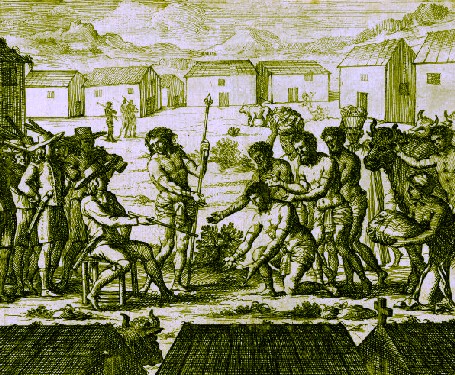
People of Careanossi Madagascar Swearing Allegiance to France, From Etienne Flacourt (1658)
The remaining accounts do give some detail about the provisions taken. One concerns Thomas Howard who had stopped at Madagascar in 1703 where his pirates found the ship of 'Oort Van Tyle' [Aert Van Tuyl]. The pirates said they had come to provision their ships to which Van Tuyl "reply’d, they could get none there, and the best Way was to be gone; however the [pirate's] Quarter-Master went ashore (where the Dutch [Van Tuyl] had made his Factory [warehouse], and had some Goods) and shot down three Oxen, which he ordered the Natives to help to cut in Pieces"12. Van Tuyl realized that the natives were friends with the pirates and, "seeing Bowen['s ship] full of Men, and hearing two more Pyrates were expected, thought fit to go off in the Night, and leave the Goods he had put on Shore."13 It seems likely that the pirates took other provisions in this instance, but nothing more is mentioned in the account.
The rest of the accounts contain examples of food taken, although they are nowhere near as colorful as the Van Tuyl incident. Henry Every made a stop at 'Johanna' (Anjouan) in early
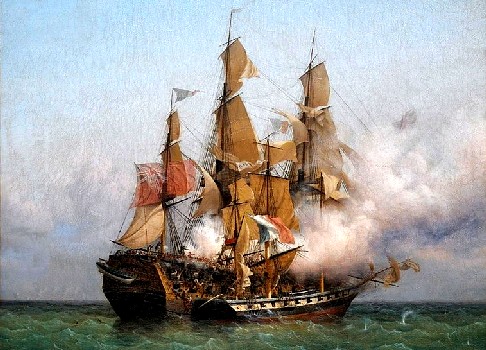
Artist: Ambroise Louis Garneray - Robert Surcouf Taking East Indiaman Kent Gulf of Bengal (c. 1850)
1695 where his crew "tooke a Junke laden with Rice, which they stood in need of"14. A few years later, pirate John Hoar attacked a small fishing town at 'Cape Mussington' (Mussendon - north of modern Limah, Oman), which they plundered, "and got good store of dates and salt fish"15.
The last example comes from the accounts of pirate John Halsey, who captured the 'Country ship' (a small, local trading vessel) named Buffalo which was commanded by an English captain named Buckley. They fought with the Buffalo, but she was quickly taken by the pirates. "This Ship fell seasonably in their Way, she being bound for Achen, with Butter, Rice, and Cloath, and the Pyrates, at that Time, being in great Streights both for Provision and Cloathing."16
Examining the East Indies-based pirates in terms of ship-based food captures versus land-based ones, the clear majority come from ships. Of the 15 events found, 12 of them describe pirates taking provisions from vessels while only 3 describe them taking them from land. This means 80% of the pirate food captures in the East Indies occurred at sea. This is not entirely surprising given that most golden age pirates operated primarily by capturing ships rather than coastal towns and villages.
1 Daniel Defoe [Captain Charles Johnson], A General History of the Pyrates, Manuel Shonhorn, ed., 1999, p. 582; 2 “36. Philip Middleton, from Narrative of Philip Middleton, 4 August, 1696. Calendar of State Papers, Colonial: America and the West Indies, 1696-1697, item. 517iii.”, Pirates in Their Own Words, Ed Fox, ed., 2014, p. 172; 3 “7. James Kelly on two decades at sea. (London, 1700)”, Pirates in Their Own Words, 2014, Fox, ed., p. 50; 4 Defoe [Charles Johnson], p. 460; 5 Defoe [Charles Johnson], p. 487-8; 6,7 Defoe [Charles Johnson], p. 488; 8 Defoe [Charles Johnson], p. 488; 9,10 Defoe [Charles Johnson], p. 485; 11 Defoe [Charles Johnson], p. 516; 12 13 Defoe [Charles Johnson], p. 516; 14 “63. Examination of John Dann. August 3, 1696., Privateering and Piracy in the Colonial Period – Illustrative Documents, John Franklin Jameson, ed., 1923, p. 167; 15 “37. Henry Watson, from Narrative of Mr. Henry Watson, who was taken prisoner by the pirates, 15 August, 1696”, Pirates in Their Own Words, Ed Fox, ed., 2014, p. 177; 16 Defoe [Charles Johnson], p. 516
Pirates Operating in the Atlantic Taking Food
The information on the Atlantic-based pirates capturing food is similar to that of the East Indies
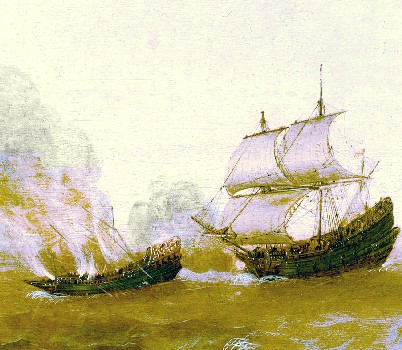
Artist: Cornelius Verbeeck - A Naval Encounter (1618-1620)
pirates. albeit on a larger scale. Of the 55 Atlantic-based pirating accounts, 42 of them only mention taking provisions. Further, of all the named pirates who took provisions, 17 of these men are never mentioned as having taken anything other than 'provisions' and the accounts of their thefts don't say much else of interest about them. These include two sea-based captures and one land-based capture at Isleatherer, Bahamas by Charles Vane during 17181, two ship-based captures by Blackbeard during the same year2, two provision thefts from ships by Francis Spriggs on the Delight in 17243, the capture of a French ship by Howell Davis in 17184, John Martel's seizure of three vessels in the Caribbean during 17165, John Rack ham's food theft at Jamaica in 17196, Richard Worley plundering two vessels in 17187, Robert Dunbar trapping several barques in the Atlantic during 16958, Samuel Bellamy, Palsgrave Williams and Olivier Levasseur taking the St. Michael in December, 17169, the taking of a variety of vessels by Stede Bonnet's Revenge in 1717 and 171810 and Thomas Anstis' seizure of four or five vessels while cruizing the Caribbean in 1721 and 172211.
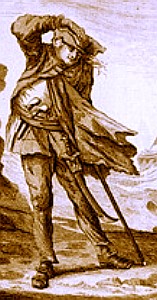
Artist: Joseph Nicholls
Pirate Edward Low (1736)
The accounts of pirate Edward Low detail some provision thefts of interest. In the summer of 1722, Low had captured several vessels in the Azores with a design to get some food and water. To this end, "Low sent to the Governor of St. Michael’s [Sao Miguel] for a Supply, and promised upon that Condition to release the Ships he had taken, but otherwise to burn them all; which Demand the Governor thought it not prudent to refuse, but sent the Provision he required; upon which he released six of the Ships, (after he had plundered them of what he thought fit)"12. Although this does not explain much about the food Low received, another account does. In June of 1722, Low's crew captured a vessel sailing from Amboy which was captained by John Hance, from whom they "took almost all the Bread and Flower he had"13. In addition to these, Low also took James Cahoone's and William Frazier's ships14 out of which they took unnamed provisions as well as "a Ship called the Liverpool Merchant, Captain Goulding, from whom they stole a great Quantity of Provisions and dry Goods"15. For the typical naval diet, 'dry goods' usually refers to oatmeal and dried peas. Although this amount of detail isn't found in the account, it is quite possible that these are what it refers to there.
There are four accounts of Low's sometime partner in piracy George Lowther stealing food from other ships while sailing in the
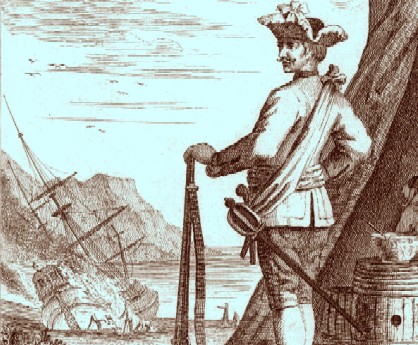
Artist: Joseph Nicholls - Pirate George Lowther Careening His Ship (1736)
Atlantic between 1721 and 1723. All of these accounts simply state that Lowther took provisions16, although there are a few other interesting details in two of them, both from 1721 when he was still sailing with fellow mutineer John Massey in the Gambia Castle.
After leaving the 'River Cambia' (near modern Banjul, Gambia in Africa) they captured a merchant ship, "secured the Sailors, and took such Provisions, Brandy, Rum, &c. as they had Occasion for upon the Seas."17 The description suggests that they had taken only those things that would keep at sea, which were likely the foods found in the navy diet such as dried foods, salt meats & biscuit. A short time after that capture, they took a couple other vessels "and solaced themselves in them, feasting upon what they found"18. This description suggests they used whatever food the found wastefully, probably gorging themselves. It is possible (although certainly not stated) that they found fresh foods on that vessel which would have decayed if kept for their voyage.
Two pirates with only a single specific mention of a provision theft in these accounts were John Breholt and John Phillips. Breholt's ship the Carlisle stopped at Sullivan's Island, Virginia 
Artist: Charles Brooking
Privateer Engaging French Ship (c. 1750)
in 1700s "and there killed a great many cows, hogs, and goats, the best of which they carried on board. He told Captain Clay he designed either to sail for Smith's Island in Virginia to get more provisions, or else to Cape de Verd [Cape Verde Islands]."19 This is a bit less dramatic theft than some of the other accounts included here, although the owner of that cattle probably didn't think so.
Phillip's food capture was quite different in that it was at sea, taking place off of Barbados in October of 1723. Charles Johnson explains in his book that the pirates
were almost starv’d for want of Provisions, being reduc’d to a Pound of Meat a Day between ten [men]; at length they fell in with a Martinico Man of 12 Guns and 35 Hands, far superior in Force, and what they would not have ventured on [attempted to capture] at another Time, but Hunger will break down Stone Walls; they were resolved to shew the French Men their black Flag…[and eventually captured her.] This proved a seasonable Supply; they took her Provisions, and four of her Men, and let her go20
Although this only involves 'provisions', the details about what they did and why they did it indicate the importance of being able to take ships with food supplies to pirates.
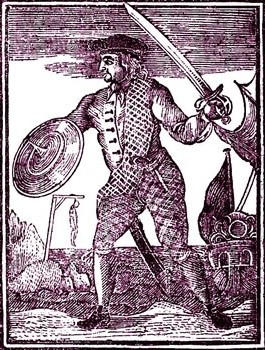
Pirate John Gow, From the General History (1725)
Accounts of Europe-focused pirate John Gow also provide some interesting fodder for the list of food captures when his ship Revenge was sailing on the coast of Spain in late 1724 and early 1725. While some of the accounts simply mention him taking provisions, others give a little more detail. Among other ships he took in November of 1724 was a Scottish snow filled with herring and salmon, some of which they kept before sinking her.21 The next month, they took the Lewis Joseph, a merchant vessel "laden with Wine, Almonds, Reasons [raisins], Oranges and Lemons [and 'some oil', probably olive oil] from Cadiz bound to France and took out all her Men and part of her Cargoe and put them on board the sd. Pirate Ship"22 because "this was in some Respect the very Thing they wanted"23. The pirates manned the merchant ship so they could divvy up the cargo, eventually deciding to shift some of it to the Revenge, "especially of the Wine, with some Oil, and a large Quantity of Almonds... with five of his best Guns, and their Carriages."24 By January of the next year, they must have still had a supply of salmon and herring from the capture in November because when they captured the Triumvirate on the 6th coming from Newfoundland, "they let her Cargo alone, for they had no occasion for Fish, but they took almost all their Provisions"25.
Not surprisingly, the most successful Atlantic-based pirate - Bartholomew Roberts - supplies the largest number of examples with 9 food captures, all taken from ships during the golden age of piracy. Over half of these simply mention his pirate crews stealing provisions including the Greyhound taken near Bermuda in November or December
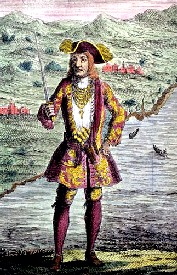
Pirate Bartholomew Roberts,
From the General History (1724)
of 171926, two Sloops overcome at the island of La Désirade in late Summer, 172027, several fishing boats captured at Trepassi, Newfoundland in October of the same year28, "several other French, Spanish and English Vessels" in 172029 and the Lloyd Galley grabbed in March, 1721 near Bermuda.30
Those aside, the remaining account of Roberts taking food furnish us with more interesting details. The first begins with the taking of a ship Captained by a man named Hingstone near Deseada (La Désirade, an island off Guadalupe) in September, 1719. Johnson explains that the pirates took Captain Hingstone's ship north "to Barbudas and plundered; and they continually met with some Consignment or other, (chiefly French) which stored them with Plenty of Provisions, and recruited their starving Condition"31. While interesting, this is not exceptionally different than many of the other accounts which simply discuss pirates making off with provisions. However, the official records give more interesting details of this capture. They state that the pirates had two ships and Hingstone's ship had 500 barrels of beef aboard before the pirates set her on fire. (They do not say whether the pirates took beef off Hingstone's ship or not.) Roberts crew set fire to at least one other ship at this time as well as capturing another ship, this one belonging to a Captain Fowle.32 Fowle sent a letter ashore at Guadalupe to James Parsons in which he asked "him to send in the morning some sheep goats etc. in a boat to the pirates. 'I am treated very civilly and promised to have my ship and cargo again and desire Capt. Henksone [Hingstone] to send his wheel that he stears his ship with, or it may be the worse for him'."33 The next
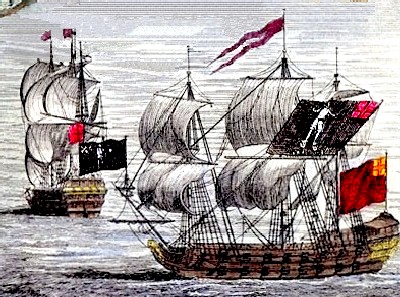
Roberts Ships Royal Fortune and Great Ranger, From the General History (1724)
day, the pirates waited off shore for the sheep, eventually sending their sloop in to get them. By then the colonists had managed to set up 13 cannon which they fired at the pirates, damaging their sails. The pirates apparently sent a boat ashore because in a letter outlining what happened, Lt. General Mathew commented, "I wish they may not have got some of your Excellency's mutton for their boat went on shoar etc."34
Several other examples of food taken by Roberts are found in the accounts under study. Around September of 1720, they grabbed a Bristol-based ship leaving Barbados, "from whom they took Abundance of Cloaths, some Money, twenty five Bales of Goods, five Barrels of Powder, a Cable, Hawser, ten Casks of Oatmeal, six Casks of Beef, and several other Goods"35. In 1721, a crew reported to be that of Roberts caught a vessel "off of St. Mary’s [probably referring to Sainte Marie on Martinique], who took from her half her Beef, and all her Butter"36. During 1721, Roberts was said to have captured two vessels off Antigua from whom he "carry’d with him 12 of the said Ship’s Men and 40 Barrels of Beef, with several other Things that made for his Turn"37. Note that in each of these captures, Roberts' men took items that were part of the naval diet including oatmeal, salt beef and butter. If this was all they had, Roberts' pirate's diet following these captures would have been about the same as that found in the English navy.
The second largest number of instances of pirates taking food are all from
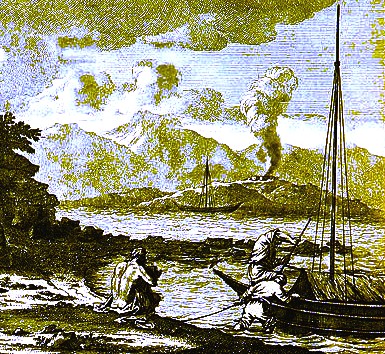
Artist: Cornelis de Bruyn - Loading a Boat, Bababarnoe,Voyage au Levant (1714)
accounts where the pirate captain's name isn't known. All save one of these come from newspaper accounts taken from witnesses. It is worth noting that such accounts often contained confused or incorrect facts. Six of them were sea-based captures and only mention the taking of 'provisions' so they are not repeated in full here.38 A seventh account states that some pirates had "taken a large French Merchant-Ship laden with Fish from Newfoundland"39, so we know what kind of food they got from it.
The final account of unknown pirates grabbing food is from a land-based capture at Smith's Island, Maryland from October of 1699. Colonel John Custis reported that "a band of twelve well armed men, having landed, had proceeded to shoot down all the cattle and hogs coming within the range of their guns. The carcasses were skinned and the meat cut up and carried off to the vessel, which, as soon as night had fallen, stole away in the darkness."40
If the fact that 80% of the Eastern pirate captures included here occurred at sea rather on land seems impressive, the captures by Atlantic-based pirates is even more so; of the 55 instances of pirates capturing food in the Atlantic, 50 of them occurred at sea. This means 91% of the time, provisions were taken at sea according to the examples found in the accounts under study. Sea captures were clearly the pirates preferred method of getting provisions.
1 Daniel Defoe [Captain Charles Johnson], A General History of the Pyrates, Manuel Shonhorn, ed., 1999, pp. 135-6 & 620 & Calendar of State Papers, Colonial: America and the West Indies, Vol. 30, Item 142; 2 Defoe [Charles Johnson], pp. 74 & 76; 3 Defoe [Charles Johnson], pp. 356 & 357; 4 Defoe [Charles Johnson], p. 168; 5 Defoe [Charles Johnson], pp. 64 & 65; 6 Post Boy, 4-23-19 - 4-25, Issue 4641; 7 Defoe [Charles Johnson], p. 298 & Original Weekly Journal, 12-27-18; 8 Post Boy and Historical Account, Issue 40, 8-8-1695 - 8-10; 9 John Franklin Jameson, “108. Examination of John Brown. May 6, 1717.”, Privateering and Piracy in the Colonial Period – Illustrative Documents, 1923, p. 294; 10 Defoe [Charles Johnson], p. 95 & 99 &, “22. David Herriot and Ignatius Pell on Blackbeard and Stede Bonnet, from The Tryals of Major Stede Bonnet, and other Pirates (London, 1719), pp. 44-48”, Pirates in Their Own Words, Ed Fox, ed., 2014, p. 106; 11 Defoe [Charles Johnson], pp. 288 & 295; 12 Defoe [Charles Johnson], pp. 323; 13 Daily Courant, 8-8-22, Issue 6489; 14 Daily Courant, 8-8-22, Issue 6489 & Defoe [Charles Johnson], pp. 328; 15 Defoe [Charles Johnson], pp. 325; 16 Defoe [Charles Johnson], pp. 315 & Select and Impartial Accounts of the Lives, Behavior, and Dying-Words Of the most Remarkable Convicts, Vol. II, 1745, p. 14; 17,18 Select and Impartial Accounts..., p. 14; 19 David Marley, Pirates of the Americas, Vol. 2, 2010, p. 539; 20 Defoe [Charles Johnson], pp. 334; 21 “33. James Williams, from The Examination of James Williams, 27 March, 1725. HCA 1/55 ff. 103-104”, Pirates in Their Own Words, Ed Fox, ed., 2014, p. 162; 22 “33. James Williams...", p. 163; 23 Select and Impartial Accounts..., p. 221; 24,25 Select and Impartial Accounts..., p. 222; 26 Defoe [Charles Johnson], pp. 220; 27 Defoe [Charles Johnson], pp. 215; 28 CSPC America and West Indies, Vol. 32, Item 251. iv; 29 “32. Thomas Lawrence Jones, from The Examination of Thomas Lawrence Jones, 13 February, 1724. HCA 1/55 ff. 50-52”, Pirates in Their Own Words, 2014, p. 159; 30 Daily Post, 6-22-21, Issue 539; 31 Defoe [Charles Johnson], pp. 223; 32 CSPC America and West Indies, Vol. 32, Item 251. iii; 33 CSPC America and West Indies, Vol. 32, Item 251. v; 34 CSPC America and West Indies, Vol. 32, Item 251. iii; 35 Defoe [Charles Johnson], pp. 215; 36 Daily Post, 7-25-21, Issue 567; 37 Daily Post, 9-2-21, Issue 601; 38 Post Boy, 11-23-99 - 11-25, Issue 723, Daily Journal, 10-10-22, Issue CCCCCXXXV, Flying Post or The Post Master, 8-1-00 - 9-3, Issue 817, New England Courant, 9-4-21 - 9-11, Issue 6, Post Man and the Historical Account, 7-6-00 - 7-8, Issue 709 & Daily Courant, 4-19-26, Issue 7646; 39 Flying Post or The Post Master, 8-31-00 - 9-3, Issue 830; 40 Philip Alexander Bruce, Institutional History of Virginia in the Seventeenth Century, 1910, p. 215-6

